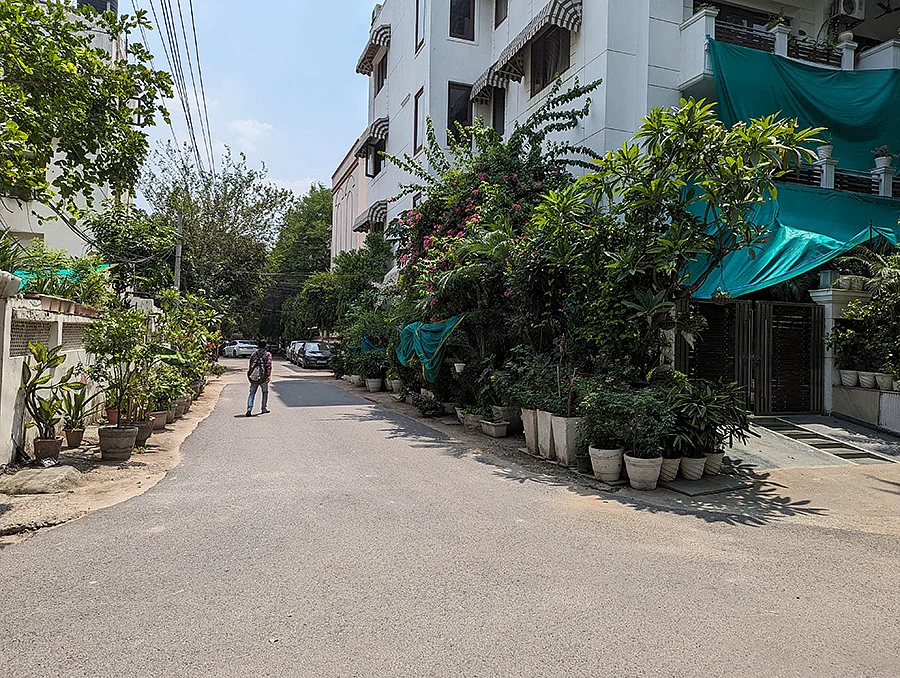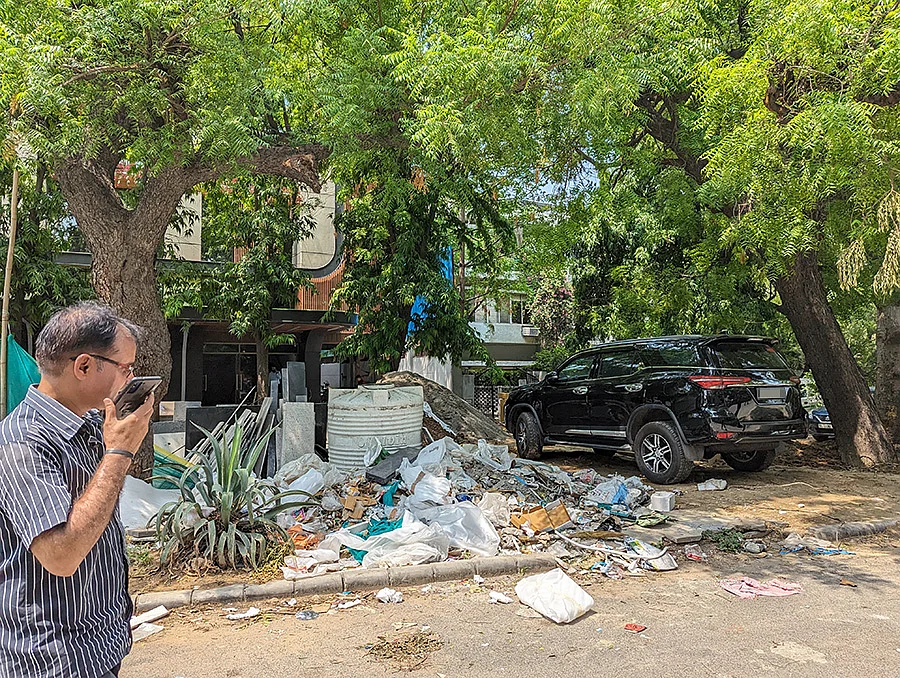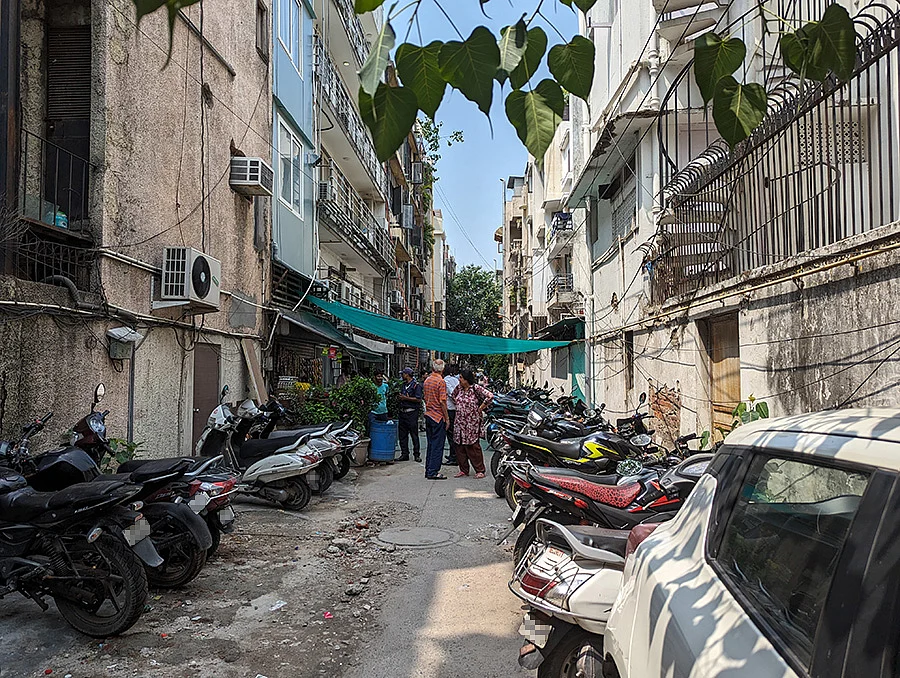In Defence Colony’s shrinking footpaths, signs of official inaction
In the first installment of this series about elite impunity for public space encroachments, a look at Defence Colony’s pattern of a quiet takeover.
White potted plants glare in Delhi’s summer sun outside a white bungalow. A security guard sits in a booth. Both of these on what was once a public footpath – now absorbed into the aesthetics of elite living.
This could be any home in a posh South Delhi colony. But unlike other parts of Delhi, where an estimated 27,000 – mostly from vulnerable sections – have been displaced in demolition drives in the last four months, such encroachments in upscale areas have barely seen any official action during this period.
When Newslaundry visited six high-income colonies in South Delhi to examine the state of footpaths, there were clear signs of a quiet takeover of public real estate.
There were five patterns of this encroachment: private car parkings, driveways cutting across pavements, guard booths, barricades reserving space for individual homes, and decorative or concrete planters embedded into walking spaces

Delhi has a total of 12,700 km of internal colony roads, of which South Delhi Municipal Corporation (SDMC) maintains the largest chunk 7,438.3 km.
According to the India Status Report 2024, prepared by IIT Delhi’s Transportation Research and Injury Prevention Centre, only 56 percent of the expected footpath length actually exists on the ground in the capital. Of this, just 26 percent meets the width and height standards prescribed by the Indian Road Congress – the apex body of highway engineers in the country, aimed at road development.
The IRC recommends a minimum footpath width of 1.8 metres and a height of no more than 150 mm above the carriageway. But walk through Defence Colony, and you’ll struggle to find any footpath that even remotely matches that description.
The transformation of Defence Colony
The colony was established in the wake of the Partition and conceived as a refuge for Indian military officers who had lost their homes across the newly-drawn border in Pakistan. The government allocated land in Delhi for their resettlement, resulting in a thoughtfully planned neighbourhood complete with a local market, small parks, clubs, and 1,618 residential plots divided into five zones.
A-block was reserved for junior officers, featuring 225-square-yard plots, while the larger 325-square-yard plots in B, C, and D blocks were allocated to senior officers. The E-block stood out with even larger plots of 867 square yards. Allotments took place in the 1950s, and most houses were built in the early 1960s, typically modest single-storey structures, later expanded with second floors and rooftop barsatis as families grew.
Today, over 65 percent of the old homes have been replaced by modern multi-storey buildings. The neighbourhood has evolved into an upscale enclave, now home to lawyers, art galleries, boutique designer stores, young couples, small families, and professionals drawn by its central location and vibrant lifestyle.
But, according to Major Ranjit Singh, president of the Defence Colony Residents’ Welfare Association, “one thing remains unchanged” in all of the colony’s 110 lanes. “The footpaths are gone.”
Newslaundry visited Block B, C and E in the area.

Block C: A former top army officer’s house
Take Block C, for instance, which shares a border with the Kushak Nala – a link to the Barapula drainage system. What should be a footpath is either shattered or simply missing due to private infrastructure.
Pramod Chopra, the RWA’s general secretary, alleges there has been no action over individual complaints. “People have even planted full-grown trees on footpaths. Now, authorities say they can't remove them.”
One of these complaints pertains to the house of a former top officer of the army, according to RWA members. Outside it lies a 2-metre-wide driveway, a guard booth, and over 200 potted plants, all on the footpath.
Even the Defence Colony Club in the same block has marked parking spots along what should be the pedestrian path. “Of course it’s a problem,” Major Singh says. “There are no footpaths. We are forced to walk on the road. For senior citizens like myself, it’s a real safety risk.”
In a city where over 44 percent of road accident deaths are pedestrians, according to the India Status Report 2024, the lack of walkable space only exacerbates the situation.
Block B: Service lanes taken over by parking lots
Defence Colony’s service lanes, meant for emergency access, tell a similar story. In Block B, Newslaundry found them completely blocked by parked two-wheelers, roadside tea stalls, and construction debris.
In a 2019 judgment in MC Mehta vs Union of India, the Supreme Court had noted that the Delhi transport department’s policy for parking rules said such lanes must be “earmarked for unhindered movement of emergency vehicles like ambulances, fire tenders, police vehicles, etc. No parking shall be allowed on this lane.”
However, in Block B, the entire length of the 750-metre service lane was marked by stalls or parked vehicles – some of these were of those visiting a private hospital next to the lane. A stall vendor even pointed to his municipal license to operate until March next year.
“The MCD shows up for half an hour, clears a few things, and leaves. Then they say it’s the police’s job to enforce it,” alleges Singh.

In E Block, ‘residents involved in encroaching’
According to RWA general secretary Chopra, the area from E-1 to E-5 is facing a green belt. Newslaundry found it encroached by cars and driveways.
It is not clear yet if buildings in the area received sanction for these driveways. An official at the MCD office says, “It is difficult to give that kind of information since records aren’t that serialised.”
Asked about the RWA’s allegations and signs of encroachments in the area, Andrews Ganj Councillor Anita Baisoya, who also represents Defence Colony, says the MCD does try to take action. “We try to remove the encroachments from the internal colony roads, but the residents themselves are involved in encroaching. For how long can we prevent them?... A lot of influential people live in the colony, and they approach people at high posts in the department, and hence the encroachment continues.”
Asked about illegal parking, Ravinder Singh, traffic in-charge of the circle, says that “there is no provision of issuing challans for illegal parking inside the colonies” and the traffic police issues challans “only after the local police inform us to take any action in a particular area”.
While this report documents multiple instances, the exact scale of such encroachments remains unquantified, with the MCD refusing to share detailed, colony-wise data on public land encroachments. A response to an RTI query said that “no such information is available in this office”.
Newslaundry reached out to the Defence Colony police station SHO Sanjay Sharma, SDMC Additional Commissioner Jitender Yadav and DCP Traffic (South) Kushal Pal Singh for comment. This report will be updated if they respond.
If you’re reading this story, you’re not seeing a single advertisement. That’s because Newslaundry powers ad-free journalism that’s truly in public interest. Support our work and subscribe today.
